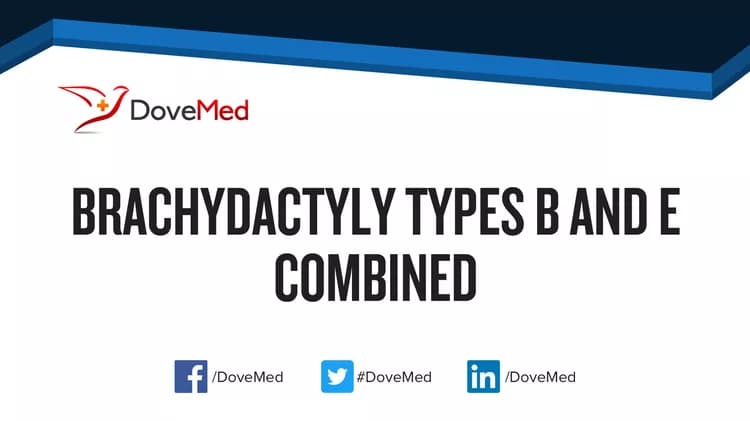What are the other Names for this Condition? (Also known as/Synonyms)
- Ballard Syndrome
- Brachydactyly, Ballard type
- Pitt Williams Brachydactyly
What is Brachydactyly Types B and E Combined? (Definition/Background Information)
- Brachydactyly Types B and E Combined (or Ballard Syndrome) is characterized by hypoplasia of the distal phalanges of the ulnar side of the hand and shortening of one or more metacarpals
- In contrast to brachydactyly type E, patients with Ballard Syndrome have normal stature
- The syndrome has been described in 12 members from four generations of one family. Transmission appears to be autosomal dominant
(Source: Ballard syndrome; Orphanet, National Institute of Health and Medical Research (INSERM), Paris.)
Who gets Brachydactyly Types B and E Combined? (Age and Sex Distribution)
- Brachydactyly Types B and E Combined is an extremely rare congenital disorder
- The presentation of symptoms may occur following the birth of the child
- Both males and females may be affected
- Worldwide, individuals of all racial and ethnic groups may be affected
What are the Risk Factors for Brachydactyly Types B and E Combined? (Predisposing Factors)
- A positive family history may be an important risk factor, since Brachydactyly Types B and E Combined is an inherited condition
- Currently, no risk factors have been clearly identified for the disorder
It is important to note that having a risk factor does not mean that one will get the condition. A risk factor increases one’s chances of getting a condition compared to an individual without the risk factors. Some risk factors are more important than others.
Also, not having a risk factor does not mean that an individual will not get the condition. It is always important to discuss the effect of risk factors with your healthcare provider.
What are the Causes of Brachydactyly Types B and E Combined? (Etiology)
- The exact cause of development of Brachydactyly Types B and E Combined is presently unknown
- It is reportedly a genetic disorder that is transmitted in an autosomal dominant manner
Autosomal dominant: Autosomal dominant conditions are traits or disorders that are present when only one copy of the mutation is inherited on a non-sex chromosome. In these types of conditions, the individual has one normal copy and one mutant copy of the gene. The abnormal gene dominates, masking the effects of the correctly function gene. If an individual has an autosomal dominant condition, the chance of passing the abnormal gene on to their offspring is 50%. Children, who do not inherit the abnormal gene, will not develop the condition or pass it on to their offspring.
What are the Signs and Symptoms of Brachydactyly Types B and E Combined?
The signs and symptoms of Brachydactyly Types B and E Combined may include:
- Brachydactyly
- Broad distal phalanx of finger
- Broad thumb
- Concave nail
- Short 4th finger
- Short 4th metacarpal
- Short 5th finger
- Short 5th metacarpal
- Short fifth metatarsal
- Short thumb
(Source: Brachydactyly Types B and E Combined; Genetic and Rare Diseases Information Center (GARD) of National Center for Advancing Translational Sciences (NCATS), USA.)
How is Brachydactyly Types B and E Combined Diagnosed?
Brachydactyly Types B and E Combined is diagnosed on the basis of the following information:
- Complete physical examination
- Thorough medical history evaluation
- Assessment of signs and symptoms
- Laboratory tests
- Imaging studies
- Biopsy studies, if necessary
Many clinical conditions may have similar signs and symptoms. Your healthcare provider may perform additional tests to rule out other clinical conditions to arrive at a definitive diagnosis.
What are the possible Complications of Brachydactyly Types B and E Combined?
The complications of Brachydactyly Types B and E Combined may include:
- Stress due to limb abnormalities
- Difficulty in performing simple/routine tasks
Complications may occur with or without treatment, and in some cases, due to treatment also.
How is Brachydactyly Types B and E Combined Treated?
Presently, there is no cure for Brachydactyly Types B and E Combined, since it is a genetic disorder. The treatment is usually given to manage the signs and symptoms and any complications that develops.
How can Brachydactyly Types B and E Combined be Prevented?
Currently, Brachydactyly Types B and E Combined may not be preventable, since it is reportedly a genetic disorder.
- Genetic testing of the expecting parents (and related family members) and prenatal diagnosis (molecular testing of the fetus during pregnancy) may help in understanding the risks better during pregnancy
- If there is a family history of the condition, then genetic counseling will help assess risks, before planning for a child
- Active research is currently being performed to explore the possibilities for treatment and prevention of inherited and acquired genetic disorders
What is the Prognosis of Brachydactyly Types B and E Combined? (Outcomes/Resolutions)
- The prognosis of Brachydactyly Types B and E Combined is dependent upon the severity of the signs and symptoms and associated complications, if any
- Individuals with mild conditions have better prognosis than those with severe symptoms and complications
- Typically, the prognosis may be assessed on a case-by-case basis
Additional and Relevant Useful Information for Brachydactyly Types B and E Combined:
The following DoveMed website link is a useful resource for additional information:
Related Articles
Test Your Knowledge
Asked by users
Related Centers
Related Specialties
Related Physicians
Related Procedures
Related Resources
Join DoveHubs
and connect with fellow professionals


0 Comments
Please log in to post a comment.